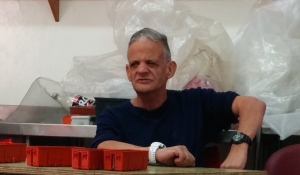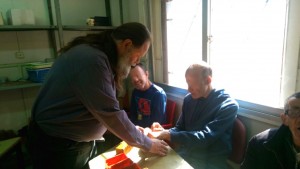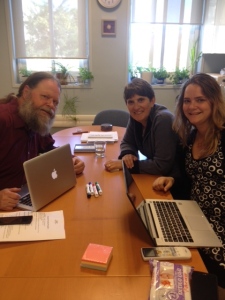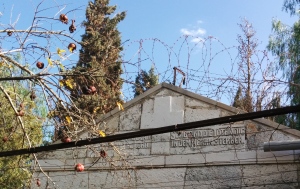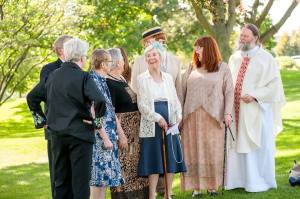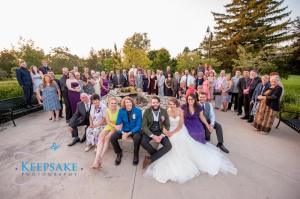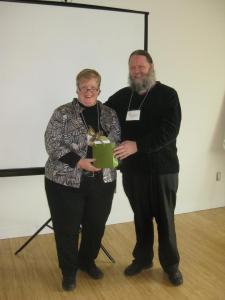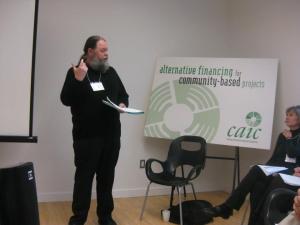Service of Holy Baptism with Eucharist for Christian Ty Leandro Chopite Santinelli August 18th, 2013
CALL TO WORSHIP
Celebrant: Blessed be God: Father, Son, and Holy Spirit.
People: And blessed be his kingdom, now and for ever. Amen. Celebrant: There is one Body and one Spirit;
People: There is one hope in God’s call to us;
Celebrant: One Lord, one Faith, one Baptism;
People: One God and Father of all. Celebrant: The Lord be with you.
People: And also with you.
Celebrant: Let us pray.
SERVICE OF THE WORD
The Collect of the Day:
Celebrant: Heavenly Father, by the power of your Holy Spirit
you give to your faithful people new life in the water of baptism. Guide and strengthen us by the same Spirit, that we who are born again may serve you in faith and love, and grow into the full stature of your Son, Jesus Christ, who is alive and reigns with you and the Holy Spirit now and for ever.
People: Amen.
The Lessons:
First Reading: A reading from the prophet Ezekiel (47:1–9. 12)
The angel brought me to the entrance of the Temple, where a stream came out from under the Temple threshold and flowed eastwards, since the Temple faced east. The water flowed from the right side of the Temple, south of the altar. He took me out by the north gate and led me right round outside as far as the outer east gate where the water flowed out on the right-hand side. The man went to the east holding his measuring line and measured off a thousand cubits; he then made me wade across the stream; the water reached my ankles. He measured off another thousand and made me wade across the stream again; the water reached my knees. He measured off another thousand and made me wade across again; the water reached my waist. He measured off another thousand; it was now a river which I could not cross; the stream had swollen and was now deep water, a river impossible to cross. He then said, ‘Do you see, son of man?’ He took me further, then brought me back to the bank of the river. When I got back, there were many trees on each bank of the river. He said, ‘This water flows east down to the Arabah and to the sea; and flowing into the sea it makes its waters wholesome. Wherever the river flows, all living creatures teeming in it will live. Fish will be very plentiful, for wherever the water goes it brings health, and life teems wherever the river flows. Along the river, on either bank, will grow every kind of fruit tree with leaves that never wither and fruit that never fails; they will bear new fruit each month, because this water comes from the sanctuary. And their fruit will be good to eat and the leaves medicinal.’
Reader: The Word of the Lord.
People: Thanks be to God.
Second Reading: CHILDREN LEARN WHAT THEY LIVE by Dorothy Law Nolte
Children learn what they live.
If a child lives with criticism
he learns to condemn.
If a child lives with hostility
he learns to fight.
If a child lives with ridicule
he learns to be shy.
If a child lives with shame
he learns to feel guilt.
BUT,
If a child lives with tolerance
he learns to be patient.
If a child lives with encouragement
he learns confidence. If a child lives with fairness
he learns justice.
If a child lives with security
he learns to have faith.
If a child lives with approval
he learns to like himself.
If a child lives with acceptance and friendship
He learns to find love in the world.
Third Reading: The Holy Gospel according to Mark. (Mark 10:13–16)
People: Glory to you, Lord Christ.
People were bringing little children to him, for him to touch them. The disciples turned them away, but when Jesus saw this he was indignant and said to them, ‘Let the little children come to me; do not stop them; for it is to such as these that the kingdom of God belongs. I tell you solemnly, anyone who does not welcome the kingdom of God like a little child will never enter it.’ Then he put his arms round them, laid his hands on them and gave them his blessing. Reader: The Gospel of the Lord.
People: Praise to you, Lord Christ.
The Sermon
Today is the birthday of my son, David. I can not easily recall when he wasn’t a part of our lives. Through all the many challenges of being a parent, having him in our lives has been wonderful and frightening and always better than it would have been without him. His views and way of living in the world are different than mine—being the father of a right wing atheist is always a challenge. But we must have done something right as he cares about others and the world he lives in, values woven into the way his whole extended family on both sides deal with the challenges of life.
As a parent you view the world differently—you want the best possible present and future for your child. You want them to be happy, to be able to control their own destiny, to be do things in the world that matter. In essence, we view our children the way God views creation. God, in what ever way we see the creator, desires the best for us.
As parents, no matter how much we love our children, we know that things aren’t always perfect. They will get sick; they will find that sometimes dreams don’t come true; they will find that people they care about will die.
And, as parents, we wish that sometimes we could do something that would allow things to start over.
The creator sees what happens in creation. God too wishes that the choices humanity sometimes make, either as individuals or on a global scale, would have been different. We make choices in life that cut us off from the life God intended for us; governments make decisions that divert us away from helping to build up the shalom kingdom here on earth. But unlike the limitations we have as parents, God does offer us something that allows us to reclaim all the possibilities of a new life—baptism.
In baptism the past is washed away and new life becomes possible. We are woven into a 2,000 year old family that, even if not perfect, still proclaims that love is better than hate, that sharing is better than selfishness, that we are all equal in the sight of God.
Being baptised doesn’t mean our life will be perfect, but it is a statement that life can be and is transformed. It is a covenant between God and the individual that no matter what happens in life one can start over.
Christian isn’t able to understand the promises that are being made today on his behalf. When older, at confirmation, he can chose to confirm these vows on his own. But people who care about him, his parents and sponsors, are making a commitment on his behalf to care for him, to give him guidance, to be examples of people able to enter into strong and living relationships. They are making a promise to us and before God that they will by precept and example help Christian grow up to be an example to others of who a good person is. All of us gathered here today are also making a promise. We are stating that we are also committed to helping to build here on earth the shalom kingdom, a place where all the promises of creation can be made real.
SERVICE OF BAPTISM
Presentation and Examination of the Candidates
The Celebrant says: The Candidate for Holy Baptism will now be presented.
Parents and Godparents: I present Christian Ty Leandro Chopite Santinelli to receive the Sacrament of Baptism.
The Celebrant: Will you be responsible for seeing that the child you present
is brought up in the Christian faith and life? Usted será responsable de ver que el niño presente ¿se crió en la fe cristiana y la vida?
Parents and Godparents I will, with God’s help. (Lo haré, con la ayuda de Dios.)
Celebrant Will you by your prayers and witness help this child to grow
into the full stature of Christ? Por sus oraciones y su testimonio ayudará a este niño crezca ¿a la plena estatura de Cristo?
Parents and Godparents: I will, with God’s help. (Lo haré, con la ayuda de Dios.)
Then the Celebrant asks the following questions of the parents and godparents:
Question: Do you renounce Satan and all the spiritual forces
of wickedness that rebel against God?
Answer: I renounce them.
Question: Do you renounce the evil powers of this world
which corrupt and destroy the creatures of God?
Answer: I renounce them.
Question: Do you renounce all sinful desires that draw you
from the love of God?
Answer: I renounce them.
Question: Do you turn to Jesus Christ and accept him as your
Savior?
Answer: I do.
Question: Do you put your whole trust in his grace and love?
Answer: I do. Question: Do you promise to follow and obey him as your
Lord?
Answer: I do. The Celebrant to the Congregation:
Celebrant: Will you who witness these vows do all in your
power to support these persons in their life in Christ?
People: We will.
Celebrant: Let us join with those who are committing themselves to Christ and renew our own baptismal covenant.
Celebrant: Do you believe in God the Father?
People: I believe in God, the Father almighty, creator of heaven and earth.
Celebrant: Do you believe in Jesus Christ, the Son of God?
People: I believe in Jesus Christ, his only Son, our Lord. He was conceived by the power of the Holy Spirit and born of the Virgin Mary. He suffered under Pontius Pilate, was crucified, died, and was buried. He descended to the dead. On the third day he rose again. He ascended into heaven, and is seated at the right hand of the Father. He will come again to judge the living and the dead.
Celebrant: Do you believe in God the Holy Spirit?
People: I believe in the Holy Spirit, the holy catholic Church, the communion of saints, the forgiveness of sins, the resurrection of the body, and the life everlasting.
Celebrant: Will you continue in the apostles’ teaching and fellowship, in the breaking of bread, and in the prayers?
People: I will, with God’s help.
Celebrant: Will you persevere in resisting evil, and, whenever you fall into sin, repent and return to the Lord?
People: I will, with God’s help.
Celebrant: Will you proclaim by word and example the Good
News of God in Christ?
People: I will, with God’s help.
Celebrant: Will you seek and serve Christ in all persons, loving your neighbor as yourself?
People: I will, with God’s help.
Celebrant: Will you strive for justice and peace among all people, and respect the dignity of every human being?
People: I will, with God’s help.
Prayers for the Candidate
The Celebrant then says to the congregation: Let us now pray for Christian Ty Chopite who is to receive the Sacrament of new birth:
Leader: Deliver him, O Lord, from the way of sin and death.
People: Lord, hear our prayer.
Leader: Open his heart to your grace and truth.
People: Lord, hear our prayer.
Leader: Fill him with your holy and life-giving Spirit.
People: Lord, hear our prayer.
Leader: Keep him in the faith and communion of your holy Church.
People: Lord, hear our prayer.
Leader: Teach him to love others in the power of the Spirit.
People: Lord, hear our prayer.
Leader: Send him into the world in witness to your love.
People: Lord, hear our prayer.
Leader: Bring him to the fullness of your peace and glory.
People: Lord, hear our prayer.
The Celebrant says: Grant, O Lord, that all who are baptized into the death of Jesus Christ your Son may live in the power of his resurrection and look for him to come again in glory; who lives and reigns now and forever. Amen.
Thanksgiving over the Water
Celebrant: The Lord be with you.
People: And also with you.
Celebrant: Let us give thanks to the Lord our God.
People: It is right to give him thanks and praise.
Celebrant: We thank you, Almighty God, for the gift of water. Over it the Holy Spirit moved in the beginning of creation. Through it you led the children of Israel out of their bondage in Egypt into the land of promise. In it your Son Jesus received the baptism of John and was anointed by the Holy Spirit as the Messiah, the Christ, to lead us, through his death and resurrection, from the bondage of sin into everlasting life. We thank you, Father, for the water of Baptism. In it we are buried with Christ in his death. By it we share in his resurrection. Through it we are reborn by the Holy Spirit. Therefore in joyful obedience to your Son, we bring into his fellowship those who come to him in faith, baptizing them in the Name of the Father, and of the Son, and of the Holy Spirit. Now sanctify this water, we pray you, by the power of your Holy Spirit, that those who here are cleansed from sin and born again may continue for ever in the risen life of Jesus Christ our Savior. To him, to you, and to the Holy Spirit, be all honour and glory, now and for ever. Amen.
Consecration of the Chrism
Celebrant: Eternal Father, whose blessed Son was anointed by the Holy Spirit to be the Savior and servant of all, we pay you to consecrate this oil that those who are sealed with it may share in the royal priesthood of Jesus Christ; who lives and reigns with you and the Holy Spirit, for ever and ever. Amen.
The Baptism
Christian Ty Leandro Chopite Santinelli, I baptize you in the Name of the Father, and of the Son, and of the Holy Spirit. Amen.
Let us pray. Heavenly Father, we thank you that by water and the Holy
Spirit you have bestowed upon these your servants the
forgiveness of sin, and have raised them to the new life of
grace. Sustain them, O Lord, in your Holy Spirit. Give them
an inquiring and discerning heart, the courage to will and to
persevere, a spirit to know and to love you, and the gift of joy
and wonder in all your works. Amen.
Christian Ty Leandro Chopite Santinelli, you are sealed by the Holy Spirit
in Baptism and marked as Christ’s own for ever. Amen. Let us welcome the newly baptized Christian Ty Chopite into our community:
Celebrant and People: We receive you into the household of God. Confess the faith of Christ crucified, proclaim his resurrection, and share with
us in his eternal priesthood.
Celebrant: The peace of the Lord be always with you.
People: And also with you.
The celebrant then says: All praise and thanks to you, most merciful Father, for
adopting us as your own children, for incorporating us into
your holy Church, and for making us worthy to share in the
inheritance of the saints in light; through Jesus Christ your
Son our Lord, who lives and reigns with you and the Holy
Spirit, one God, for ever and ever. Amen.
Almighty God, the Father of our Lord Jesus Christ, from
whom every family in heaven and earth is named, grant you
to be strengthened with might by his Holy Spirit, that, Christ
dwelling in your hearts by faith, you may be filled with all the
fullness of God. Amen.
The Eucharist
COMMUNION:
Celebrant: Blessed are you, Lord God of the Universe. You are the giver of this bread, fruit of the earth and of human labour. Let it become for us the bread of life.
People: Blessed be God, now and forever.
Celebrant: Blessed are you, Lord God of the Universe. You are the giver of this wine, fruit of the vine and of human labour. Let it become for us the wine of the eternal kingdom. People: Blessed be God, now and forever.
Celebrant: As the grain once scattered in the fields and the grapes once dispersed on the hillside are now reunited on this table in bread and wine, so Lord may your whole Church soon be gathered together from the corners of the earth into your Kingdom. People: Blessed be God, now and forever.
Celebrant: May God be with you. People: And also with you.
Celebrant: Open your hearts. People: We open them to God and one another.
Celebrant: Let us give thanks to God. People: It is right to give God thanks and praise.
Celebrant: It is indeed right that we should praise you, gracious God, for you created all things. You formed us in your own image, male and female you created us. When we turned away from you in sin, you did not cease to care for us, but opened a path of salvation for all people. You made a covenant with Israel, and through your servants Abraham and Sarah gave the promise of a blessing to all nations. Through Moses you led your people from bondage into freedom; through the prophets you renewed your promise of salvation. Therefore, with them, and with all your saints who have served you in every age, we give thanks and raise our voices to proclaim the glory of your name: All: Holy, Holy, Holy God, God of power and might, Heaven and earth are full of your glory. Hosanna in the highest! Blessed is the one who comes in the name of the Lord! Hosanna in the highest!
Celebrant: Holy God, source of life and goodness, all creation rightly gives you praise. In the fullness of time, you sent your son Jesus Christ, to share our human nature, to live and die as one of us, to reconcile us to you, the God and Father of all. He healed the sick and ate and drank with outcasts and sinners; he opened the eyes of the blind and proclaimed the good news of your kingdom to the poor and those in need. In all things he fulfilled your gracious will. On the night he freely gave himself to death, our Lord Jesus Christ took bread, and when he had given thanks to you, he broke it, and gave it to his disciples, and said, “Take, eat: this is my body which is given for you. Do this for the remembrance of me.” After supper he took the cup of wine; and when he had given thanks, he gave it them, and said, “Drink this, all of you: this is my blood of the new covenant, which is shed for you and for many for the forgiveness of sins. Whenever you drink it, do this for the remembrance of me.” Gracious God, his perfect sacrifice destroys the power of sin and death; by raising him to life you give us life for ever more. Therefore we proclaim the mystery of faith. All: Christ has died. Christ is risen. Christ will come again.
Celebrant: Recalling his death, proclaiming his resurrection, and looking for his coming again in glory, we offer you this bread and this cup. Send your Holy Spirit upon us and upon these gifts, that all who eat and drink at this table may be one body and one holy people, a living sacrifice in Jesus Christ, our Lord. Through Christ and with Christ and in Christ, in the unity of the Holy Spirit, all glory is yours, almighty Father, now and forever. All: Amen.
FRACTURE AND DISTRIBUTION
Celebrant: The body of Christ, broken for you. The blood of Christ, shed for you. Let us share, for all things are made new.
POST-COMMUNION PRAYER
All: For the bread we have eaten, for the wine we have tasted for the life we have received, we thank you, O God. Grant that what we have done and have been given here may so put its mark upon us that it may remain always in our hearts. Grant that we may become mature Christians, that ours may be the faith which issues in action; through Christ our Lord. Amen.
COMMISSIONING AND BENEDICTION
Celebrant: Let us go from this place in peace, to love and serve God. And may the blessings of God, the creator, redeemer and sustainer of us all be with you this day and always. People: And also with you. All: Amen.
POSTSCRIPT:
Thank you for attending Ty’s Baptism. Your company and presence in this important celebration is greatly valued and appreciated.
In love and faith, The Parents and Godparents of Christian Ty Leandro Chopite Santinelli
Prelude and Postlude Music:
Quiet City for Cor Anglais, Trumpet and Strings (Celia Nicklin, Michael Laird, Academy of St. Martin In the Fields & Sir Neville Marriner)
Symphony No. 1 in B-flat major (Spring), op. 38, IV: Allegro animato e grazioso (Milan Horvat: ORF Radio Symphony Orchestra)
The Planets, Op. 32: II. Venus, The Bringer of Peace (John Eliot Gardiner & Philharmonia Orchestra)
Dream Children Op. 43: II Allegretto piacevole (Andrew Davis & BBC Symphony Orchestra)
Joan Baez Suite, Op. 144 – 7. Finale (Sharon Isbin)
Il Sogno – Act 2: Sleep (Michael Tilson Thomas: London Symphony Orchestra)

